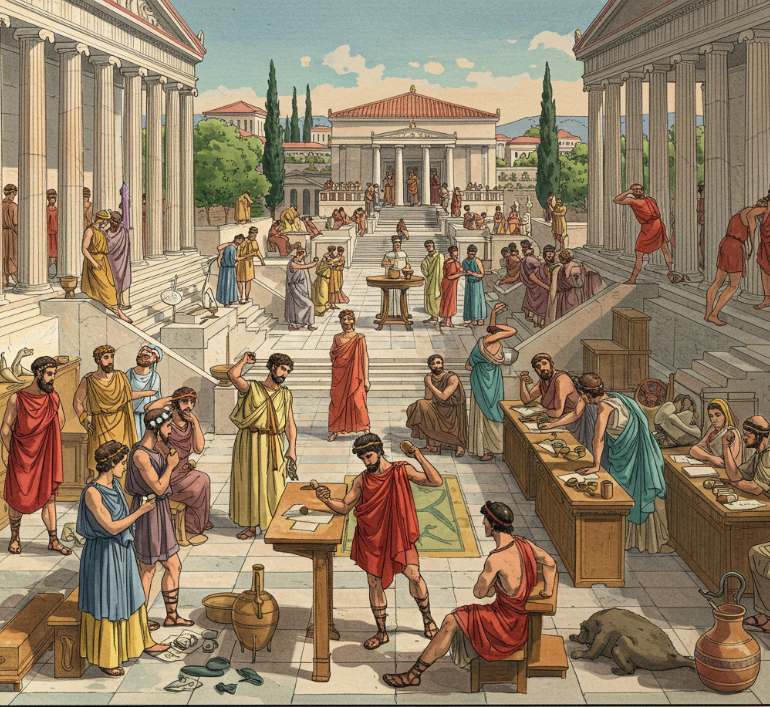The ancient Greeks may have built sacred temples on sites previously hit by earthquakes as they believed the land held spiritual powers.
New research has found a number of sacred sites in the Aegean region - which covers the surrounding areas of the Aegean Sea in Greece and Turkey - were built over fault lines.
Fault lines can release natural springs of water, which ancient Greeks used for certain ancient rituals to help purify them.
They can also at times release toxic fumes that may have inspired 'divine visions' in some ancient Greeks.
Ancient Greek city Delphi was home to the Temple of Apollo (pictured), an important sanctuary that was built over the same earthquake fault line twice
Scientists have previously thought that the ancient city Delphi was built over an earthquake fault line.
The early settlement is the site of the Temple of Apollo, which is thought to have been built around sacred springs and intoxicating fumes that rose from the faults.
But Iain Stewart, Professor of Geoscience Communication at the University of Plymotuh, suggests that other cities, including Mycenae, Ephesus, Cnidus and Hierapolis were built in response to earthquake activity.
The ancient Greeks chose to construct their most important buildings over areas affected by seismic activity as they awarded them special cultural status.
The researcher found evidence of this as earthquake-formed landscape features were used in construction.
The early settlers used underground fault lines as pathways for groundwater and building exits.
They also used the uneven ground created by earthquakes as limestone walls for structures.
Cities were formed from the uneven ground created by the earthquakes, including Mycenae (pictured)
The study showed how ancient people may have chosen to situate Greek cities close to the natural springs and fountains that leaked from the fault lines.
Natural springs played a vital therapeutic role in the ritual practices of early settlements.
In Greek Medicine, water has expulsive properties, as it washes waste and impurities from the body.
Ritual often included prayer and washing, to remove the dirt of daily life or specific impurities.
Purification was an important part of Greek religious practices. The aim of purification, or cleansing, was to rid the person of pollution.
Pollution could be caused by an act of sin or immorality.
Fault lines could also produce toxic fumes which may have triggered divine frenzies in some ancient Greeks.
As the ancient cities in the study are placed in such close proximity to the faults (directly above them), Mr Stewart believes that a relationship between the two is highly likely.
Cnidus (left) and Ephesus (right) in Turkey are two more cities that are said to have been built directly above sites of earthquake activity
Early human settlers are also said to have used the underground fault lines and natural springs that erupted from the earthquakes to build cities such as Hierapolis in Turkey (pictured)
The landscape of the Aegean region is known both for being riddled with faults, and for its high number of ruined settlements.
Greece sits at meeting point of three shifting tectonic plates, which continually stretch and move the area, causing faults.
Many faults in the Aegean region run straight through the ancient settlements’ most sacred spaces.
It is now thought that the building of settlements close to earthquakes sites may not be purely by chance.
‘I have always thought it more than a coincidence that many important sites are located directly on top of fault lines created by seismic activity,’ Mr Stewart wrote.
‘The ancient Greeks placed great value on hot springs unlocked by earthquakes, but perhaps the building of temples and cities close to these sites was more systematic than has previously been thought.’
One example that seems to prove the theory is found in Delphi.
The Temple of Apollo, the most important building in the city, was destroyed by an earthquake in 373BC.
The new study shows how cities and sacred cities across the Aegean region are specifically located above earthquake fault lines. Delphi and Mycenea in Greece, and Ephesus, Hierapolis and Cnidus in Turkey are all included
The Temple of Apollo (pictured) is believed to have gained important status in Classical Greek civilisation due to its sacred springs and the intoxicating fumes that rose from the fault lines it was built on
However, it was later rebuilt onto the same fault line that had once ruined it.
The articled, published in Proceedings of the Geologists' Association, also notes that many settlements built around fault lines would have been destroyed by seismic activity.
The earthquakes would also have disrupted important water sources.
Mr Stewart wrote: ‘I am not saying that every sacred site in ancient Greece was built on a fault line.
‘But while our association with earthquakes nowadays is that they are all negative, we have always known that in the long run they give more than they take away.
‘The ancient Greeks were incredibly intelligent people and I believe they would have recognised this significance and wanted their citizens to benefit from the properties they created.’














